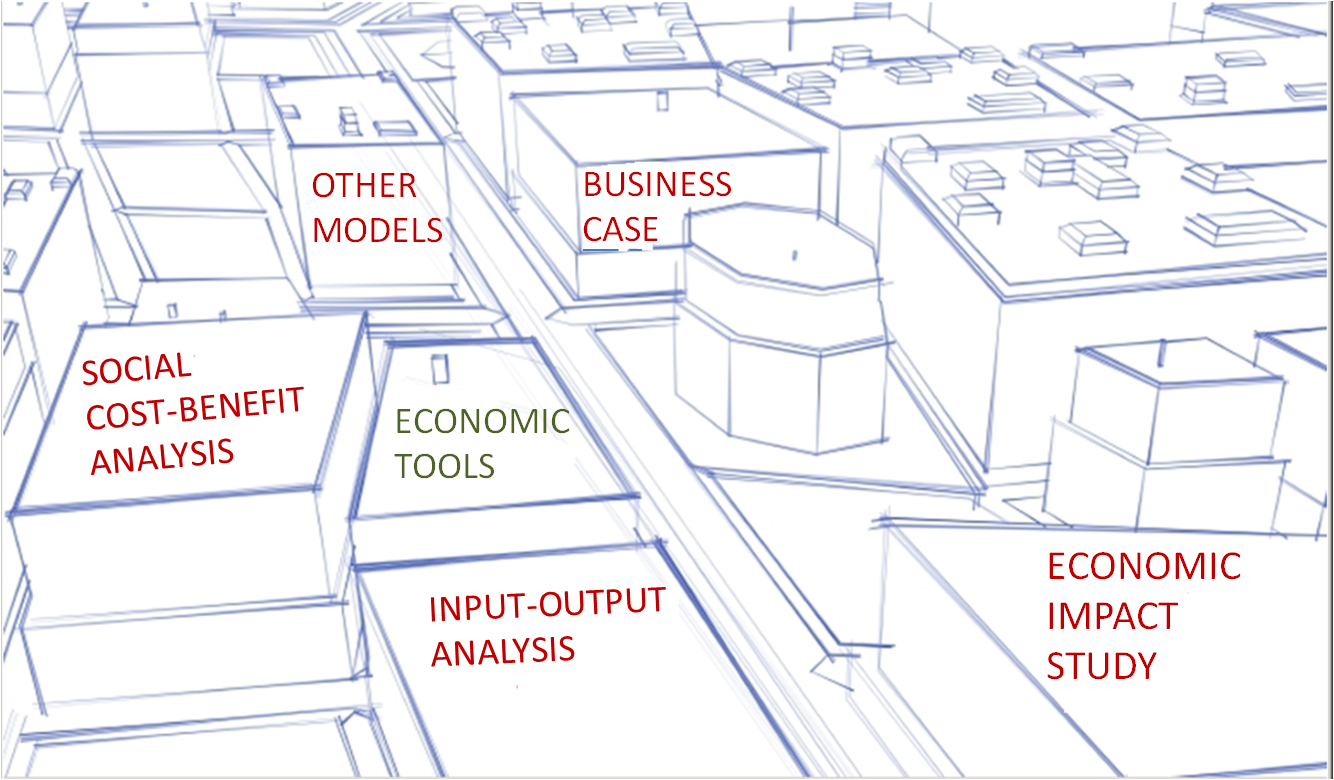Social cost-benefit analysis
Contents
Social cost-benefit analysis
Social cost-benefit analysis is a systematic and cohesive economic tool(method) to survey all the impacts caused by an urban development project[1]. It comprises not just the financial effects (investment costs, direct benefits like tax and fees, et cetera), but all the social effects, like: pollution, safety, indirect (labour) market, legal aspects, et cetera. The main aim of a social cost-benefit analysis is to attach a price to as many effects as possible in order to uniformly weigh the above-mentioned heterogeneous effects. As a result, these prices reflect the value a society attaches to the caused effects, enabling the decision maker to form a statement about the net social welfare effects of a project.
Relevance
Knowlegde about economic models/tools such as the social cost-benefit analysis can help the urban planner to systematically survey all the relevant (socio-economic) impact caused by an urban development and security threats. This insight will help the responsible urban planners to make the best choices from an socio-economic point of view.
The null hypothesis
A major advantage of a social cost-benefit analysis is that it enables investors to systematically and cohesively compare different project alternatives. Hence, these alternatives will not just be compared intrinsically, but will also be set against the "null alternative hypothesis". This hypothesis describes "the most likely" scenario development in case a project will not be executed. Put differently, investments on a smaller scale will be included in the null alternative hypothesis in order to make a realistic comparison in a situation without "huge" investments.
Measured impacts
The social cost-benefit analysis calculates the direct (primary), indirect (secondary) and external effects:
- Direct effects are the costs and benefits that can be directly linked to the owners/users of the project properties (e.g., the users and the owner of a building or highway).
- Indirect effects are the costs and benefits that are passed on to the producers and consumers outside the market with which the project is involved (e.g., the owner of a bakery nearby the new building, or a business company located near the newly planned highway).
- External effects are the costs and benefits that cannot be passed on to any existing market because they relate to issues like the environment (noise, emission of CO2 etc.), safety (traffic, external security) and nature (biodiversity, dehydration etc.).
The model engineers try to quantify and monetize as much effects as possible. Effects that cannot be monetized are presented in such a way that they can be compared. This way, policymakers can include these effects in their final judgment if an urban planning project (or a particular variation) is worth investing in. The method of monetizing effects can also influence the outcome of a social cost-benefit analysis and predictions will always remain uncertain. Therefore, the results of a social cost-benefit analysis are not absolute. Nevertheles, it is a sufficient instrument to investigate the strong and weak points of the different alternatives.
Results of a social cost-benefit analysis
The result of a social cost-benefit analysis are:
- An integrated way of comparing the different effects. All relevant costs and benefits of the different project implementations (alternatives) are identified and monetized as far as possible. Effects that cannot be monetized are described and quantified as much as possible.
- Attention for the distribution of costs and benefits. The benefits of a project do not always get to the groups bearing the costs. A social cost-benefit analysis gives insight in who bears the costs and who derives the benefits.
- Comparison of the project alternatives. A social cost-benefit analysis is a good method to show the differences between project alternatives and provides information to make a well informed decision.
- Presentation of the uncertainties and risks. A social cost-benefit analysis has several methods to take economic risks and uncertainties into account. The policy decision should be based on calculated risk.
Risk of Double counting
The impact of an urban development project can be measured in two or more ways. For example, when an improved highway reduces travel time, the value of real estate property in areas served by the highway will be enhanced. The increase in property values due to the project is a possible way to measure the benefits of a project. But if the increased property values are included, it is unnecessary to include the value of the time saved by the improvement in the highway. Unnecessary, because the value of the real estate property went up because of improvement in reach ability, so including both the increase in property values and the time saving reduction, would lead to a double counting.
Moral (ethical) aspects of socio-economic methods
Moral aspects of socio-economic methods are a fundamental aspect of any economic decision. The public interest is more than the difference between financial costs and benefits, and includes ethical aspects like balance between indivual and collective interests, the intrinsic value of nature and human life, the (universal) right to live in a secure environment, and so on.
Related subjects
Urban planning processes employ a host of other economic tools/models:
See also the clickable map below:
Other related subjects:
Footnotes and references
- ↑ In the Netherlands, conducting a social cost-benefitanalysis is mandatory for major infrastructure projects.
MAP
<websiteFrame> website=http://securipedia.eu/cool/index.php?wiki=securipedia.eu&concept=Social_cost-benefit_analysis height=1023 width=100% border=0 scroll=auto align=middle </websiteFrame>
<headertabs/>

